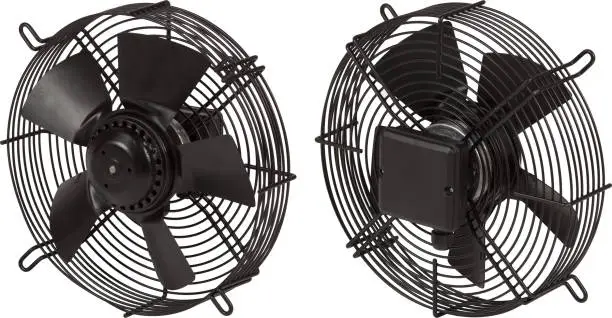Keeping machines cool on a noisy factory floor is no small task. Engineers crave solutions that sip power, hush the racket, and still get the job done. Enter the EC fan-the electronically commutated workhorse pushing performance into a new era.
In this post we’ll pull back the curtain on how these fans tick and why production managers are choosing them by the truckload. Well also see what ACDC FAN, a company that has spent decades living and breathing ventilation, brings to the table with its wide selection of EC models.
What Is an EC Fan?
The term EC describes a mixed-bag motor that borrows tricks from both AC and DC worlds. A built-in controller turns a plain AC outlet into smart juice for a brushless DC rotor. Speed can float between a crawl and a sprint based on real-time cooling needs.
Because the system modulates itself on the fly, power use drops like a stone once airflow demands ease up. Less strain on bearings and circuits usually translates into years of fuss-free operation and a sharper pencil when it finally hits the replacement list.
EC fans come with their own built-in gadgetry that handles motor timing and speed, so you never have to bolt on a freestanding drive. That turn-key design shrinks the footprint of the fan and lets it slide into tight spots where airflow has to be tuned just right.
If you want to see how many shapes and ratings these fans come in, pop over tohttps://www.acdcecfan.com/fr/products/ec-fan . The site lists units for all the normal voltages and stacks on several protection grades.
Why EC Fans Are Gaining Popularity in Industrial Settings
Factories and office buildings keep hearing the same demand: shave watts without crippling cooling power. Enter the EC fan, which bites off that problem with a few clever tricks.
High Energy Efficiency
The electronically commutated motor lurking inside these fans sips a surprising amount less juice-often 30 to 50 percent compared to a legacy AC model. That lightened load really adds up in places such as server halls or telecom racks, where row after row of fans hum around the clock.
Variable Speed Operation
Speed is not a guessing game. The fan speeds up, slows down, or hangs steady based on pulse-width modulation, analog volts, or whatever sensor data is cruising by at the moment. That on-demand behavior keeps airflow and cooling sharp while dodging wasted electricity.
Compact Integration
EC fans pack a lot of power in a small footprint. By ditching extra controllers and cutting back on wires, they free up precious room inside crowded panels and modular cabinets. Designers love that the part count drops without any fancy engineering tricks.
Low Noise and Heat Generation
Thanks to their brushless setup, EC fans trim both noise and runaway heat. That quiet, cool operation matters in places like telecom shelters, lab benches, and factory aisles where every decibel-and-degree counts. Operators report the sound level feels more like white noise than machinery.
Longer Lifespan and Reduced Maintenance
The same brushless design that keeps noise down also guards the motor from grind-and-binding wear. Built-in safety circuits catch trouble before it spreads, so fans keep spinning while everything else gets serviced. For manufacturers that measure uptime in dollars, the lower maintenance chore list is a win.
Key Industrial Applications for EC Fans
Because they blend efficiency with everyday reliability, EC fans keep showing up in all sorts of industrial heat-control jobs.
HVAC and Air Handling Systems
Building managers install EC fans in rooftop chillers and split-system air handlers to trim energy bills without sacrificing comfort. The ability to slow the blades lets the system wound up gently rather than roar to life. That smooth ramp keeps ducts quieter and buildings happier.
Telecommunication Infrastructure
Walk or drive past a modern cell site and you can almost feel the hum of electronics inside. Without steady cooling those circuits would quit, so engineers lean on EC fans. The motors automatically tweak their speed, blowing just enough air to stop hotspots while saving power when demand drops. Signal reliability rides on that simple but clever adjustment.
Data Centers and Server Rooms
Step into a server hall and the air hits like a cool wind tunnel. That chill keeps processors happy, and EC fans play a quiet starring role. They sniff out warm pockets and speed up only where needed, trimming the Power Usage Effectiveness number that finance teams love to brag about. The math is dry, but every decimal saved adds up to real money.
Control Panels and Industrial Equipment
Factory control panels can feel like small pressure cookers if left unchecked. PLCs, inverters, and a tangle of sensors each have their own thermal cut-offs. EC fans slot into those cabinets to yank heat away, keeping everything under its magic temperature line. When the door seals tight, those fans are the only promise of cool air.
Power Electronics and Renewable Energy Systems
Picture an electric-vehicle charger hooked to a solar inverter, both baking under noon sun. If the electronics cook, green-energy bragging rights evaporate with them. IP-rated and high-temp EC fans rush in, surviving grit, moisture, and the occasional heat wave. In rough outdoor gear, a trustworthy fan can be the difference between sunny-day profit and warranty-driven returns.
Picking the Right EC Fan: Quick Tips
When it comes to fan selection, plain numbers aren’t enough. The fan must fit the job, plain and simple.
Figure Out Your Air Need
First, calculate how much air your gear eats up. Cooling pros usually talk in CFM (cubic feet per minute) or m3/h. EC fans shine in setups with shifting pressure and airflow, yet even they have to be sized right to really deliver.
Check the Voltage Before Ordering
Most EC fans accept a wide voltage swing like 110-240V. Still, double-check that your shop’s wiring matches the fan’s range so you don’t wind up with a last-minute headache.
Control Options Bring Flexibility
Modern EC fans aren’t just plug-and-play; they talk back. Many accept:
- PWM for sharp digital speed tweaks.
- 0-10V for smooth, analog adjustments.
- FG and RD pulses to keep an eye on rotation and health. Fans with these inputs slip neatly into smart grids and maintenance dashboards.
Toughen Up for the Elements
Dust, water, and wild temperatures can wreck a fan faster than you think. IP-rated units, whether IP55 or the beefier IP68, add layers of protection and keep running when everything else quits.
Certifications and Compliance
Most B2B buyers aren’t thrill-seekers; they just want parts that clear every global checkpoint. CE, UL, RoHS, TÃœV-when a fan carries those marks, paperwork shrinks and border drama disappears. One stamped label can turn a headache into a quick sign-and-go.
Customization Support
Standard sizes and fixed specs feel safe until they don’t fit your rack. That’s why some shops call ACDC FAN for an OEM or ODM twist. Change the diameter, bump the CFM, or flip the mount pattern-every tweak is an invitation to engineers who like problems that keep other designers up at night.
ACDC FAN in the EC Fan Industry
Cooling challenges are multiplying, and cookie-cutter fans are losing their edge. With 20-plus years spinning blades under pressure, ACDC FAN has learned that reliability is the real ace in the hole.
The catalog stretches from wrist-watch volts to heavy-duty currents, and every model can be dressed for its job. IP seals fend off dust storms, and the high-temp variants shrug off heat that would turn paper to ash. Sound-sensitive enclosures and green-tech racks alike find a friendly face here, backed by the stickers and papers that trading partners expect.
What really sets ACDC FAN apart in the B2B world is that it doesn’t just promise quality; it builds it into every fan. Think of product consistency, relaxed support for custom work, and quick answers from tech teams- that-s the daily routine. Its factory lines carry the right stamps of certification, so there-s no guessing game. Add a culture that keeps pushing for fresh ideas and lets you count on the gear for the long run, and you-re almost done sketching the company’s profile.
Pick the fan that fits your specs and team up with someone who has seen plenty of projects. Most buyers discover they end up saving energy today and keeping the system alive tomorrow.









